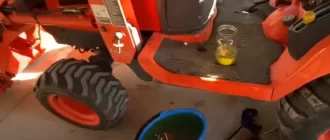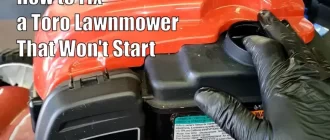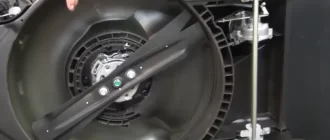Damage caused by water can result in significant issues for your lawn mower, affecting its overall functionality and durability. However, there is no need to worry as repairing a water-damaged lawn mower can be accomplished with the right knowledge and expertise, making it a manageable undertaking.
Understanding the Damage Caused by Water to a Lawn Mower
If water gets into your lawn mower, it can damage the metal parts and weaken the oil, reducing its ability to lubricate effectively. Additionally, having water in the fuel system of your mower can cause it to stutter or not start at all. It is crucial to promptly deal with these problems to avoid long-term harm and maintain the optimal functioning of your mower.

Assessing the Extent of the Damage and Necessary Repairs
The first step in repairing your water-damaged lawn mower is assessment. Drain and replace the fuel and oil, check for rusting parts and, if necessary, replace the spark plug. It’s also recommended to have a professional check for any deeper engine issues. Acting swiftly and considering the extent of damage will help revive your beloved lawn mower back to its maximum efficiency.
Immediate Steps to Take
When your lawn mower accidentally takes a dip, fast action is crucial. The faster you act, the better chances of your mower getting back in action.
Removing the Lawn Mower from Water and Drying It
The first step is the removal of the lawn mower from the water. It’s key to handle the tool carefully to avoid causing further damage. Afterwards, let it sit and dry in a warm, well-ventilated area. This is a critical step, as it allows any interior water residue to evaporate.
Cleaning the Exterior and Removing Excess Water
Once the lawn mower is completely dry, clean up the exterior using a soft cloth. Check for water in places like the fuel tank, oil filler tube and air filter compartment. Using an air compressor can be a practical solution to blow out excess water from various parts—ensuring that the smallest nooks and crannies of your mower aren’t harbouring any hidden water.
Removing Water from Engine
One of the critical steps in handling a water-damaged lawn mower is removing the water from the engine. This process requires meticulous attention to detail to successfully restore the mower to its former working condition.
Draining the Fuel Tank and Carburetor
Getting rid of water in the fuel tank and carburetor is paramount. Drain the fuel tank completely and discard the old fuel which may have been contaminated. Use a fuel stabilizer to clean the carburetor, ensuring that any water residue left in the delicate parts is completely removed. This helps to prevent stalled engines and hard starting.
Drying Out the Engine Components
Upon draining the fuel tank and carburetor, it’s time to dry out the engine components. Carefully dry each component using an air compressor, paying attention to the spark plug and ignition system. Once all parts are thoroughly dried and cleaned, the lawn mower should return to its optimal performance.
Checking and Replacing Damaged Parts
After the task of drying the engine, the immediate next step is to check for any permanent damage that water might have caused. This includes inspecting critical components such as the spark plug and the air filter, and testing the ignition system and electrical components.
Inspecting the Spark Plug and Air Filter
Thorough examination of the spark plug and air filter is crucial as these parts are highly susceptible to water damage. It’s best to replace the spark plug if there’s any sign of rust or corrosion, as it could adversely affect the mower’s performance. Similarly, the air filter should be replaced if soaked as it may no longer provide optimum filtration.
Testing the Ignition System and Electrical Components
Lastly, test the mower’s ignition system and other electrical components to ensure they’re functioning correctly. Water can interfere with electrical parts and may cause malfunctions. If there are any issues, consider seeking professional help for replacement or repair. Through diligent checking and replacing of damaged parts, you can effectively revitalize a water-damaged lawn mower.
Restoring Functionality
Once all the critical components are checked and, if need be, replaced, the next challenge lies in restoring the functionality of the lawn mower.
Reassembling the lawn mower and testing its operation
The lawn mower should be carefully reassembled, ensuring each component fits into its rightful place. Once satisfied, they can then proceed to test its operation. Push the start button and cautiously observe the performance. Does it start smoothly? Are there any unusual sounds? If not, the revitalization procedure can be deemed successful. However, it’s advisable to conduct a few more tests to be ceratin of its reliable functionality.
Replacing any necessary parts for optimal performance
Despite a successful restoration, they need to observe the mower during its operation. If they notice any discrepancies or drops in performance, it may imply that some parts still need replacement for optimal performance. Hence, it’s crucial to promptly replace these parts to prevent future damages and maintain efficiency.
Preventive Measures
Preventing water damage is essential for the longevity and efficient performance of your lawn mower. Here are some proactive measures you can take to protect your lawn mower from water damage.
Tips for Preventing Water Damage to Your Lawn Mower in the Future
Mind the Weather: Always examine the weather forecast before mowing. The onset of unexpected rain during this task can really damage initially dry parts.
Check for Leaks: Before and after usage, always inspect your lawn mower for potential leaks. Too much water can cause oxidation leading to parts rusting over time.
Proper Storage Practices and Routine Maintenance
Store Properly: Always ensure your lawn mower is stored in a dry, preferably indoor area. Exposure to moisture can cause irreversible damage to many of its components.
Regular Maintenance: Routine maintenance such as lubrication and blade sharpening can also prolong the life and functionality of your lawn mower. Include checks for water intrusion during these routines. Regular preventative maintenance can diagnose potential issues before they become major problems.
Conclusion
Maintaining a healthy and functional lawn mower isn’t as daunting as it may seem. It involves a blend of preventive measures and regular maintenance that every lawn mower owner can execute with little effort.
If your lawn mower suffers from water damage, don’t despair. The path to recovery involves thoroughly drying out the mower, replacing waterlogged components, and ensuring no moisture remains trapped. If the job seems too complex, don’t hesitate to seek assistance from professional mechanics.
With these insights, you won’t only be fixing current issues but also preventing potential future problems. The key to a long-lasting lawn mower lies in regular inspections, proper storage practices, and routine maintenance, as nothing beats the cost-effectiveness and convenience of prevention.






